The buenos aires tetra, also known as the red cross tetra (Hyphessobrycon anisitsi), is a resilient and popular freshwater fish in the aquarium trade. Known for its adaptability, this species can thrive in a wide range of water conditions and is easy to care for, making it an excellent choice for beginner aquarists. With a long lifespan and simple breeding requirements, the buenos aires tetra is a hardy fish that doesn’t demand specialized care.
However, despite its hardiness, there are a few unique care considerations you should be aware of to ensure your fish thrives. In this guide, we’ll explore everything you need to know about successfully keeping buenos aires tetras, from their ideal tank setup to their behavior and diet.
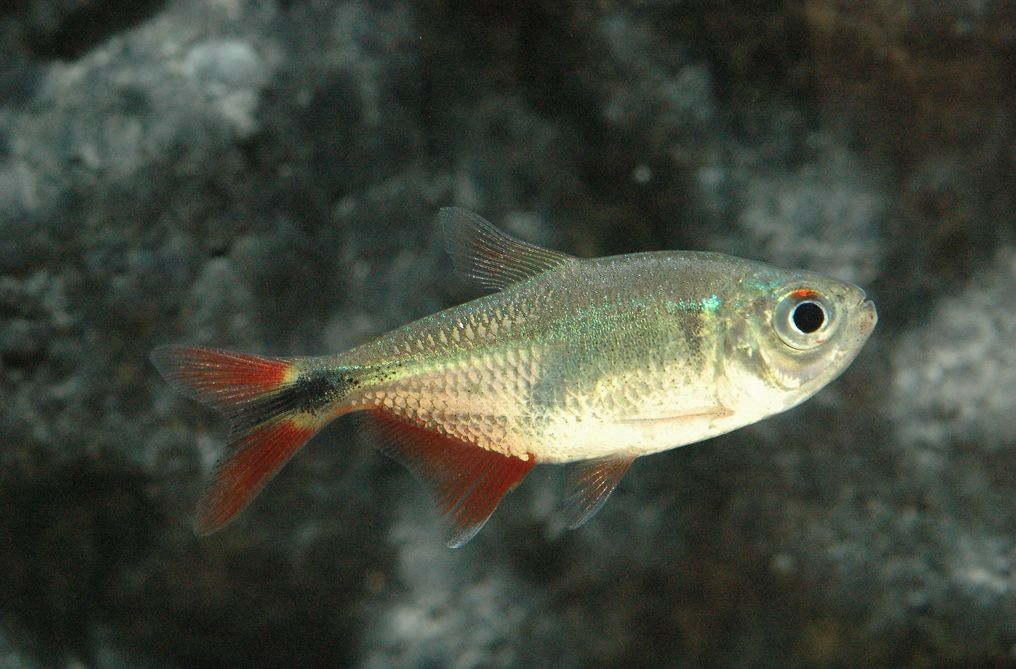
Contents
Habitat in the wild
The buenos aires tetra was first described by the ichthyologist Carl Henry Eigenmann in 1907. Native to South America, these tetras are found in the rivers, streams, and flooded areas of Argentina, Brazil, and Paraguay, primarily within the Paraná River basin.
As a schooling species, buenos aires tetras are known for their adaptability to various freshwater habitats. They inhabit diverse environments such as rivers, lakes, streams, and ponds, typically preferring areas with slow to moderate water flow. Fast-moving or turbulent waters are not their preferred territory. In their natural surroundings, these tetras thrive among dense vegetation, often seen swimming through submerged aquatic plants, floating plants, and along riverbanks lined with marginal vegetation. These lush areas provide them with shelter and mimic the conditions they need to flourish in aquariums.
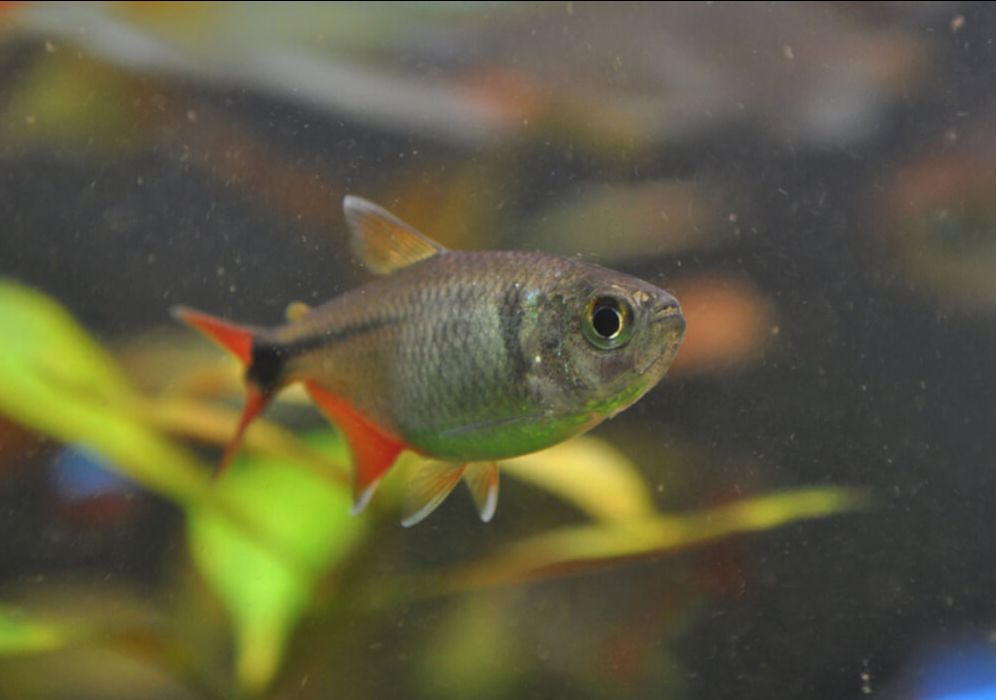
Description
Color
The buenos aires tetra is known for its striking appearance, featuring an elongated, streamlined body that allows for agile swimming. Its silvery body shimmers in the water, while the back displays a subtle blend of brown and olive tones. The fins, which range in color from reddish to yellowish, add a vibrant contrast to the overall silvery hue. One of the most eye-catching features of this tetra is the dark, diamond-shaped spot near the base of its tail fin, accompanied by a distinct red tint on the upper part of the eye. These markings, along with the fish’s active swimming behavior, make the buenos aires tetra a captivating addition to any freshwater aquarium.
The albino buenos aires tetra, a color variant of this species, lacks pigmentation, resulting in a pale or white body. Instead of the typical silver tones, this variant displays a soft, pearlescent sheen. Its fins, though less colorful than the wild type, still maintain the distinct shape and activity that make this species a lively and appealing aquarium inhabitant.
Size
Compared to other tetra species, the buenos aires tetra is relatively large, with adult specimens typically reaching 2.5 to 3 inches (6 to 8 cm) in length. While this is the average size for mature individuals, growth can vary slightly depending on factors like genetics, diet, and environmental conditions. A well-maintained tank with proper nutrition can influence the fish’s growth, resulting in healthier and slightly larger specimens.
Lifespan
Buenos aires tetras can live for an impressive 5 to 7 years in captivity when provided with optimal care. Their lifespan, however, can vary depending on several factors, including genetics, water quality, diet, and overall care. Maintaining clean water, offering a balanced diet, and ensuring a stress-free environment are essential for keeping these fish healthy and extending their life. By meeting their needs and maintaining proper water conditions, you can help your buenos aires tetras thrive for many years in your aquarium.
| Characteristic | Description |
|---|---|
| Common Name | Buenos Aires Tetra; red cross tetra; red cross fish |
| Scientific Name | Hyphessobrycon anisitsi |
| Origin | Paraná River basin in South America (Argentina, Brazil, Paraguay) |
| Size | Up to 2.5-3 inches (6-8 cm) |
| Appearance | Silvery body with a black spot at the base of the tail fin |
| Fin Colors | Red or orange |
| Temperament | Generally peaceful, but can be slightly nippy in smaller groups |
| Preferred Water Temp. | 68-79°F (20-26°C) |
| Preferred pH Level | 6.5-7.5 |
| Diet | Omnivorous; accepts high-quality flakes, pellets, live, and frozen foods |
| Compatibility | Generally compatible with non-aggressive fish species |
| Group Behavior | Shoaling fish; keep in groups of at least six individuals |
| Aquarium Setup | Heavily planted with hiding spots and open swimming areas |
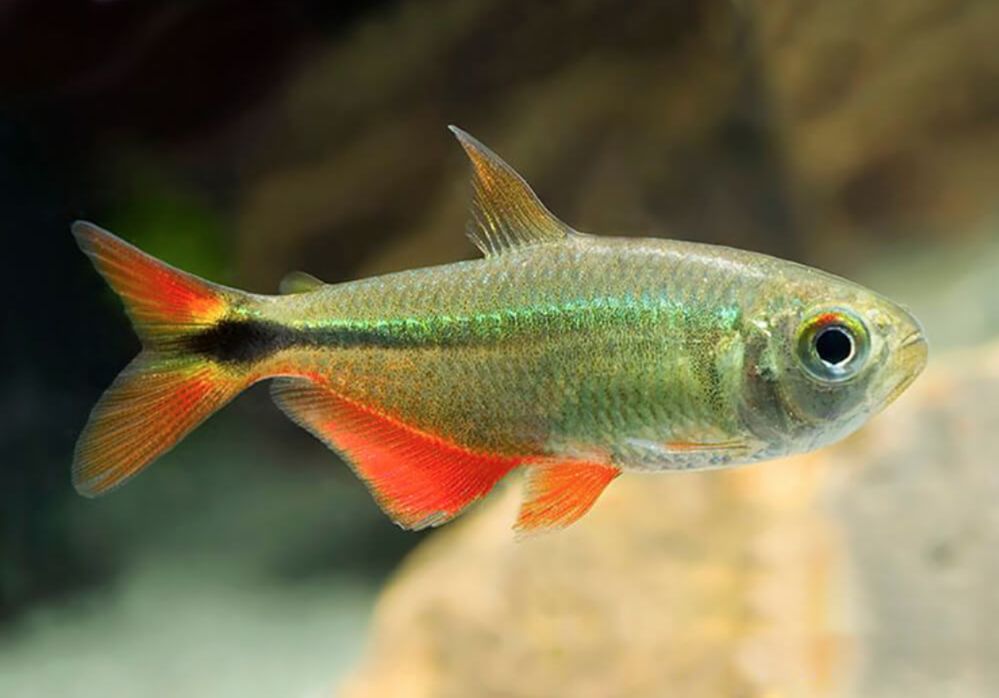
Difficulties in keeping
The buenos aires tetra is a great choice for beginner aquarists due to its hardiness, simple care requirements, and ability to thrive in various tank conditions. However, there are a few considerations to keep in mind.
These tetras have a tendency to nip the fins of other fish and may also damage soft, delicate plants, so be cautious when adding them to planted tanks. It’s best to use hardy plants, and the tank should be securely covered, as buenos aires tetras are known to jump.
It’s recommended to keep them in schools of at least 7 individuals. When kept in smaller groups, they may become aggressive toward other tank mates. Additionally, while generally active, they can be quite timid, and when they sense danger, the entire school may retreat into thick vegetation. Despite their schooling nature, occasional aggression toward their own kind can occur, especially if they are stressed or in an overcrowded tank.
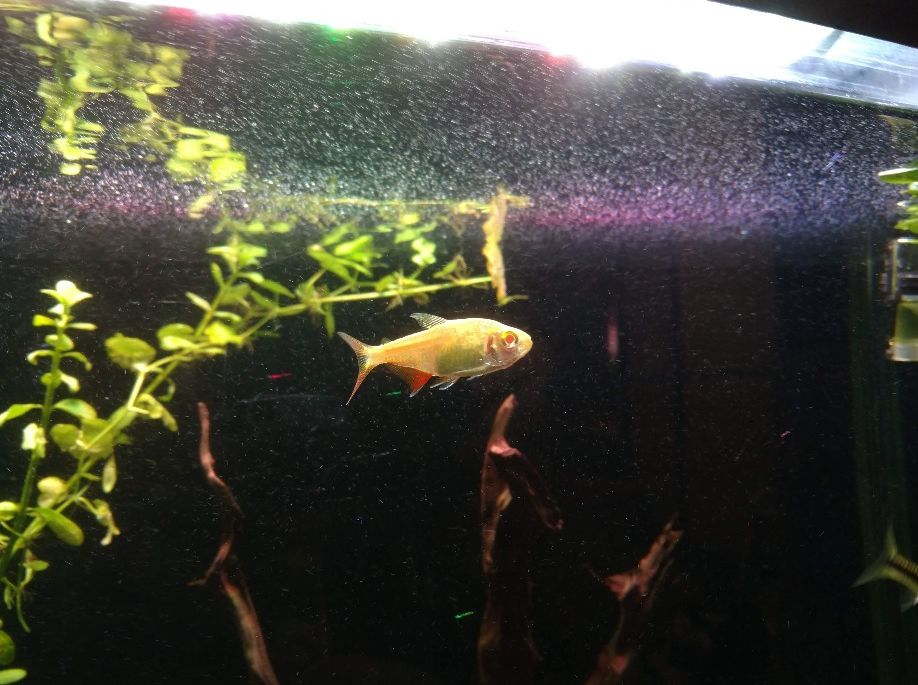
Care and keeping in a tank
The buenos aires tetra is relatively easy to keep, even in a community tank. However, while generally hardy and undemanding, it’s important to note that this fish can be somewhat aggressive. For the best results, choose fast, similarly sized tank mates to minimize any potential issues. Also, be sure to keep the tank tightly covered, as they are known to jump.
When it comes to plants, buenos aires tetras tend to eat most types, with the exception of tougher species like java moss and anubias. If having lush greenery in your tank is important, this may not be the best species for you. To help reduce their tendency to nibble on plants, consider incorporating foods rich in vegetables into their diet. This can satisfy their cravings and help preserve the tank’s plants.
Tank size
A minimum tank size of 20 gallons (75 liters) is recommended for a small school of buenos aires tetras. This provides them with plenty of room to swim and ensures they have enough space to display their natural, active behavior. As these fish are fast swimmers, open areas in the tank are essential for their comfort. Balancing the tank with hardy plants, decorations, and open spaces will help create a natural, stimulating environment where they can thrive.
Water parameters
The buenos aires tetra is generally easy to care for and isn’t too demanding when it comes to tank conditions. As a tropical species, it thrives in warm water, with a recommended temperature range of 68-79°F (20-26°C). This ensures optimal health, activity, and even breeding. While these tetras can tolerate small temperature fluctuations for short periods, sudden or extreme changes should be avoided to prevent stress or illness.
For water chemistry, buenos aires tetras prefer a pH range of 6.5-7.5, mimicking the slightly acidic to neutral waters of their natural habitat in the Paraná River basin. Additionally, the general hardness (GH) should ideally be maintained between 4-12 dGH. This provides the essential minerals they need for overall health and well-being. Keeping stable water conditions is key to helping these tetras thrive in your aquarium.
Substrate
There are no special requirements to the bottom substrate or to the tank lighting.
Ultimately, the choice of substrate depends on your preferences, the desired aesthetics, and the compatibility with your aquarium’s setup. Whichever substrate you choose, it’s essential to properly clean and rinse it before adding it to the aquarium to remove any debris or dust. Additionally, regular maintenance, such as vacuuming the substrate during water changes, is important to prevent the buildup of waste and maintain water quality.
Diet
In their natural habitat, buenos aires tetras feed on insects and algae. Fortunately, they are not particularly fussy in the aquarium and accept a variety of foods, including frozen, live, and artificial options.
A balanced diet for buenos aires tetras should include high-quality flake or pellet foods designed for tropical fish. Look for options that feature a mix of ingredients such as fish meal, shrimp, spirulina, and plant matter. Since these tetras often nibble on plants in the tank, incorporating vegetable-based foods into their diet is essential. Allowing some algae growth in the tank can also provide natural grazing opportunities.
While buenos aires tetras enjoy live food, such as daphnia, they are also known to catch falling bloodworms as they sink. They tend to avoid food that settles at the bottom, so offering slowly sinking foods is a practical way to ensure they get enough to eat. Providing a varied diet will help keep them healthy and satisfied.
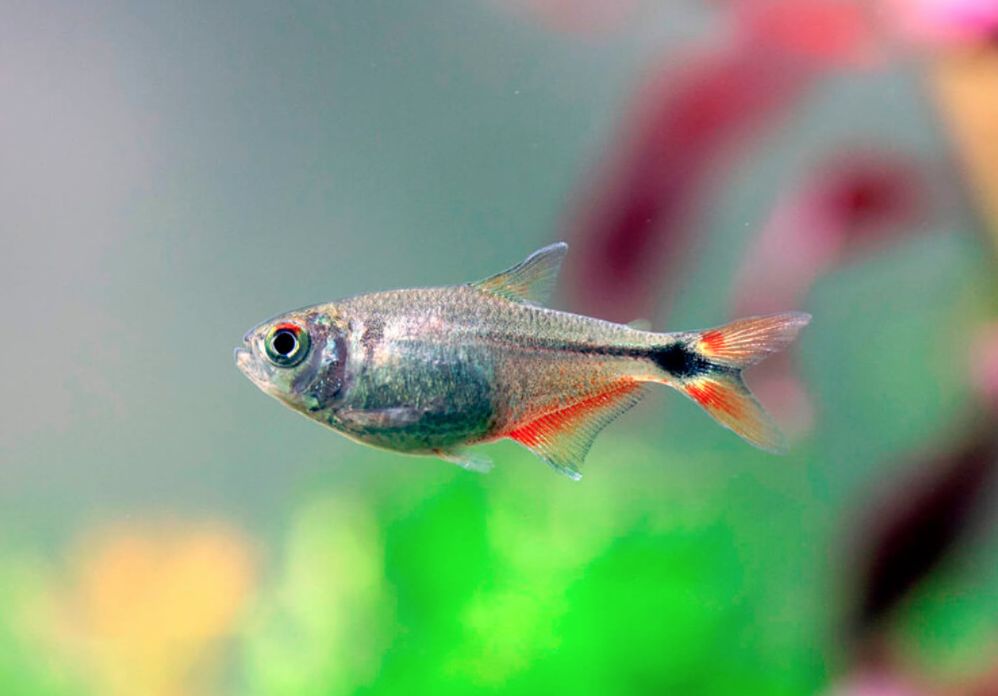
Tank mates
Buenos aires tetras are shoaling fish and thrive when kept in groups of six or more individuals. They feel more secure and display their natural behaviors when kept in a sizable group. Buenos aires tetra swim in schools and they are active all the time. At the slightest sign of danger the whole school hides in tank plants. Keeping the fish in a school of its kind is what reduces its natural aggressiveness.
They are generally peaceful fish that can coexist with a variety of tank mates. However, slow and long finned fishes (goldfishes, angelfishes, guppies) will anyway suffer when dwelling in one tank with Buenos Aires tetra.
Here’s a table suggesting potential tank mates for Buenos Aires tetras (Hyphessobrycon anisitsi) in a community aquarium:
| Species | Temperament | Size |
|---|---|---|
| Neon Tetra (Paracheirodon innesi) | Peaceful | 1-1.5 inches (2.5-3.8 cm) |
| Ember Tetra (Hyphessobrycon amandae) | Peaceful | 0.8-1 inch (2-2.5 cm) |
| Harlequin Rasbora (Trigonostigma heteromorpha) | Peaceful | 1-1.5 inches (2.5-3.8 cm) |
| Cardinal Tetra (Paracheirodon axelrodi) | Peaceful | 1.5 inches (3.8 cm) |
| Cherry Barb (Puntius titteya) | Peaceful | 2 inches (5 cm) |
| Panda Corydoras (Corydoras panda) | Peaceful | 1.5 inches (3.8 cm) |
| Honey Gourami (Trichogaster chuna) | Peaceful | 2 inches (5 cm) |
| Dwarf Gourami (Trichogaster lalius) | Peaceful | 2-3 inches (5-7.6 cm) |
| Swordtail (Xiphophorus hellerii) | Peaceful | 3-4 inches (7.6-10 cm) |
| Black Skirt Tetra (Gymnocorymbus ternetzi) | Semi-Aggressive | 2.5 inches (6.4 cm) |
| Pearl Gourami (Trichogaster leeri) | Peaceful | 4-5 inches (10-12.7 cm) |
| Zebra Danio (Danio rerio) | Active, Peaceful | 2 inches (5 cm) |
| Bristlenose Pleco (Ancistrus sp.) | Peaceful | 4-6 inches (10-15 cm) |
Gender differences: male vs female
Determining the sex of buenos aires tetras can be quite challenging, especially with younger or less mature fish. Sex differentiation becomes easier during breeding periods, as females become visibly swollen with eggs. For those interested in breeding, observing courtship behaviors and secondary sexual characteristics provides a more reliable method for sex determination. Males, for example, often develop breeding tubercles on their gill covers or pectoral fins.
Here are some subtle differences between male and female tetras that can help in distinguishing between the sexes:
- Body Shape: Males are generally slimmer and more streamlined, while females tend to have a slightly rounder belly, especially when carrying eggs.
- Coloration: Males often display more intense and vibrant colors compared to females, with their fins, particularly the dorsal fin, being more brightly colored.
- Black Spot: Both males and females have a prominent black spot near the base of the tail fin, known as the caudal peduncle. However, this spot may be more pronounced and intense in males.
- Behavior: During breeding and courtship, males are typically more active and aggressive, often chasing females and showcasing their vibrant colors to attract them.
Breeding
Prepare a small tank (up to 20 liters capacity) with fresh settled water for breeding. It’s good if the tank is elongated, 25-30 cm high. Leave its center empty and put some tank plants near the walls.
When everything is ready, put a female and two male there. The tetra should live separately for several days before this. At first the female wards off the males and they stay on the other side of the tank.
This can last for a day and sometimes longer, till reproductive products get ready. Then, usually in the morning, the males start haunting the female fish and they bring her into the center of tank plants, where she lays eggs and they are fertilized.
The eggs are very small and they are scattered in large numbers in many different directions; they stick to tank plants and spill on the tank bottom. This game is repeated several times. Each time the female lays eggs she and the males eat the eggs, but there are so many of them, that still about several hundreds of eggs are left.
After the buenos aires tetra spawns several times, you should remove both of them from the tank and put them into different volumes, so the female can rest.
In 2-3 days small juveniles hatch from the eggs and they hang of tank plants and walls. During this time you should feed them with infusorian or live small microorganisms and sufficiently aerate the tank water.
On the second day of their life the juveniles start swimming in schools and stay where there is a lot of food and eat it. They grow very fast and on the 8-10th day of their life they eagerly feed on cyclops. Next year the juveniles become reproductive.
In 10-15 day you can repeat the spawning with the same female, but it’s better to put some other male. During the second spawning there are usually less eggs.